Analysis of Duty of Care, Breach, Causation, and Defenses in Tort Law
VerifiedAdded on 2020/04/07
|6
|1399
|120
Homework Assignment
AI Summary
This assignment presents an IRAC (Issue, Rule, Application, Conclusion) analysis of a tort law scenario. The analysis begins by establishing whether a duty of care existed between Michelle and Rebecca, using the neighbor test. It then examines whether Michelle breached this duty, considering the standard of care and her actions. The assignment proceeds to determine if Michelle's actions caused Rebecca's injuries, focusing on the 'but for' test. Furthermore, the analysis explores potential defenses, specifically contributory negligence and voluntary assumption of risk. The conclusion addresses the applicability of these defenses based on the facts presented, supported by relevant case law, including Donahue v Stevenson, Overseas Tankship Ltd. v Morts Dock & Engineering Company Ltd., and Nettleship v Weston. The assignment provides a comprehensive overview of the key elements of negligence and potential defenses in tort law.

IRAC 1
Issues: In the present question, there are several issues that need to be decided.
Therefore on the basis of the facts that have been provided in this question, the issue arises if
Michelle had a duty of care towards Rebecca.
Rule: The duty of care is related with the circumstances and the relationships in which it has
recognized by the law as resulting in a legal duty to take care. On the other hand, if such care is
not taken, it may result in the liability of the defendant to pay damages to the other party, to
whom injury or loss has been caused as a result of such breach of duty (Topp v London Country
Bus, 1993). Hence, in such cases, the claimant is under a legal obligation to establish that the
defendant had a duty of care. To find out the presence of duty of care in cases involving personal
injury or damage to property, the neighbor test is used. This test was originally provided by Lord
Atkins in Donahue v Stevenson (1932).
Application: In the present case, it can be said that it was reasonably foreseeable for Michelle
that her actions may result in causing injury to Rebecca. Any driver would have known that in
case of an accident, the passenger may suffer serious injuries.
Conclusion: The conclusion regarding this issue is that Michelle had a duty of care towards
Rebecca.
IRAC 2
Issue: It also needs to be seen if these duty of care has been breached by Michelle.
Rule: According to this test, there should be reasonable foresight of harm, and a relationship of
proximity should also be present between the parties (Overseas Tankship Ltd. v Morts Dock &
Engineering Company Ltd., 1961).
Issues: In the present question, there are several issues that need to be decided.
Therefore on the basis of the facts that have been provided in this question, the issue arises if
Michelle had a duty of care towards Rebecca.
Rule: The duty of care is related with the circumstances and the relationships in which it has
recognized by the law as resulting in a legal duty to take care. On the other hand, if such care is
not taken, it may result in the liability of the defendant to pay damages to the other party, to
whom injury or loss has been caused as a result of such breach of duty (Topp v London Country
Bus, 1993). Hence, in such cases, the claimant is under a legal obligation to establish that the
defendant had a duty of care. To find out the presence of duty of care in cases involving personal
injury or damage to property, the neighbor test is used. This test was originally provided by Lord
Atkins in Donahue v Stevenson (1932).
Application: In the present case, it can be said that it was reasonably foreseeable for Michelle
that her actions may result in causing injury to Rebecca. Any driver would have known that in
case of an accident, the passenger may suffer serious injuries.
Conclusion: The conclusion regarding this issue is that Michelle had a duty of care towards
Rebecca.
IRAC 2
Issue: It also needs to be seen if these duty of care has been breached by Michelle.
Rule: According to this test, there should be reasonable foresight of harm, and a relationship of
proximity should also be present between the parties (Overseas Tankship Ltd. v Morts Dock &
Engineering Company Ltd., 1961).
Paraphrase This Document
Need a fresh take? Get an instant paraphrase of this document with our AI Paraphraser
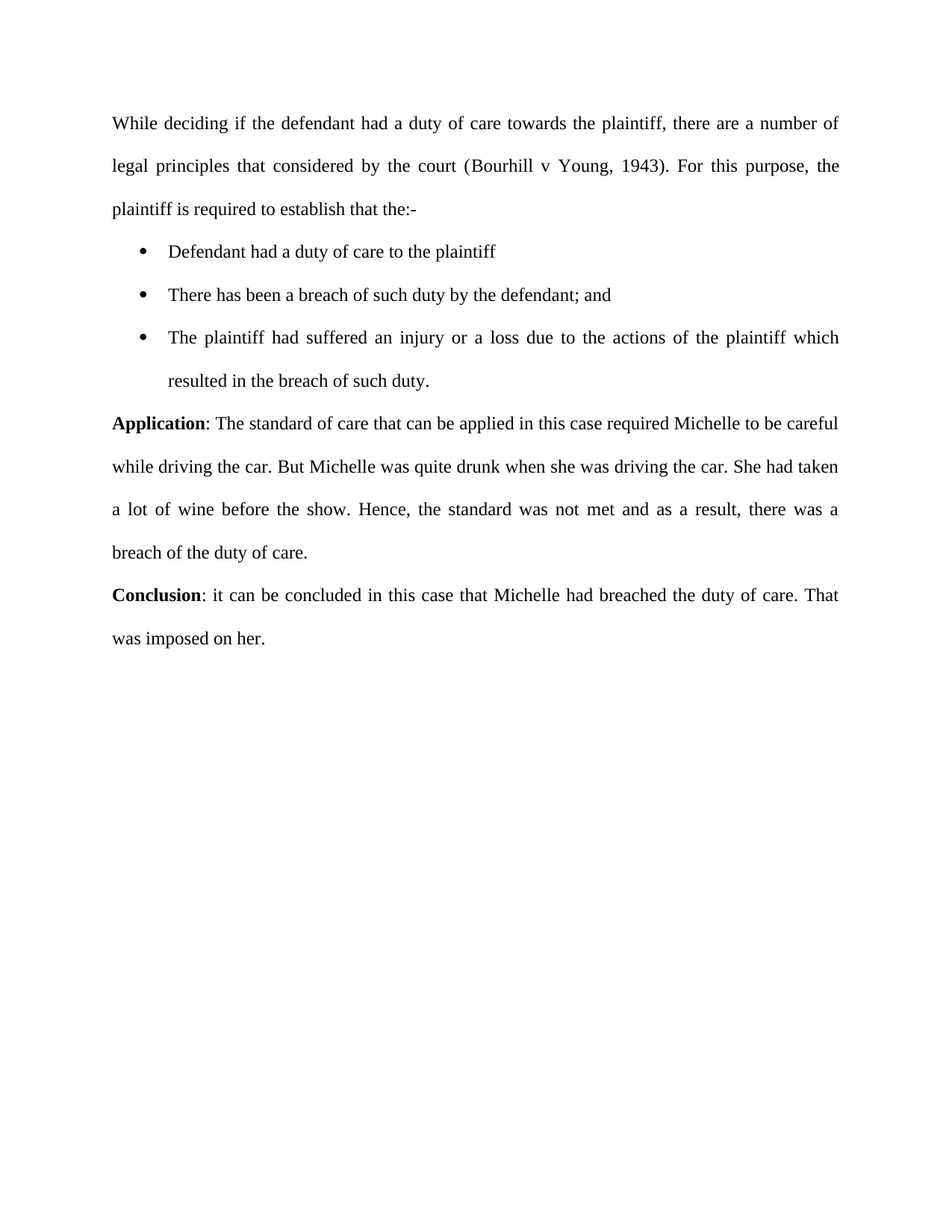
While deciding if the defendant had a duty of care towards the plaintiff, there are a number of
legal principles that considered by the court (Bourhill v Young, 1943). For this purpose, the
plaintiff is required to establish that the:-
Defendant had a duty of care to the plaintiff
There has been a breach of such duty by the defendant; and
The plaintiff had suffered an injury or a loss due to the actions of the plaintiff which
resulted in the breach of such duty.
Application: The standard of care that can be applied in this case required Michelle to be careful
while driving the car. But Michelle was quite drunk when she was driving the car. She had taken
a lot of wine before the show. Hence, the standard was not met and as a result, there was a
breach of the duty of care.
Conclusion: it can be concluded in this case that Michelle had breached the duty of care. That
was imposed on her.
legal principles that considered by the court (Bourhill v Young, 1943). For this purpose, the
plaintiff is required to establish that the:-
Defendant had a duty of care to the plaintiff
There has been a breach of such duty by the defendant; and
The plaintiff had suffered an injury or a loss due to the actions of the plaintiff which
resulted in the breach of such duty.
Application: The standard of care that can be applied in this case required Michelle to be careful
while driving the car. But Michelle was quite drunk when she was driving the car. She had taken
a lot of wine before the show. Hence, the standard was not met and as a result, there was a
breach of the duty of care.
Conclusion: it can be concluded in this case that Michelle had breached the duty of care. That
was imposed on her.
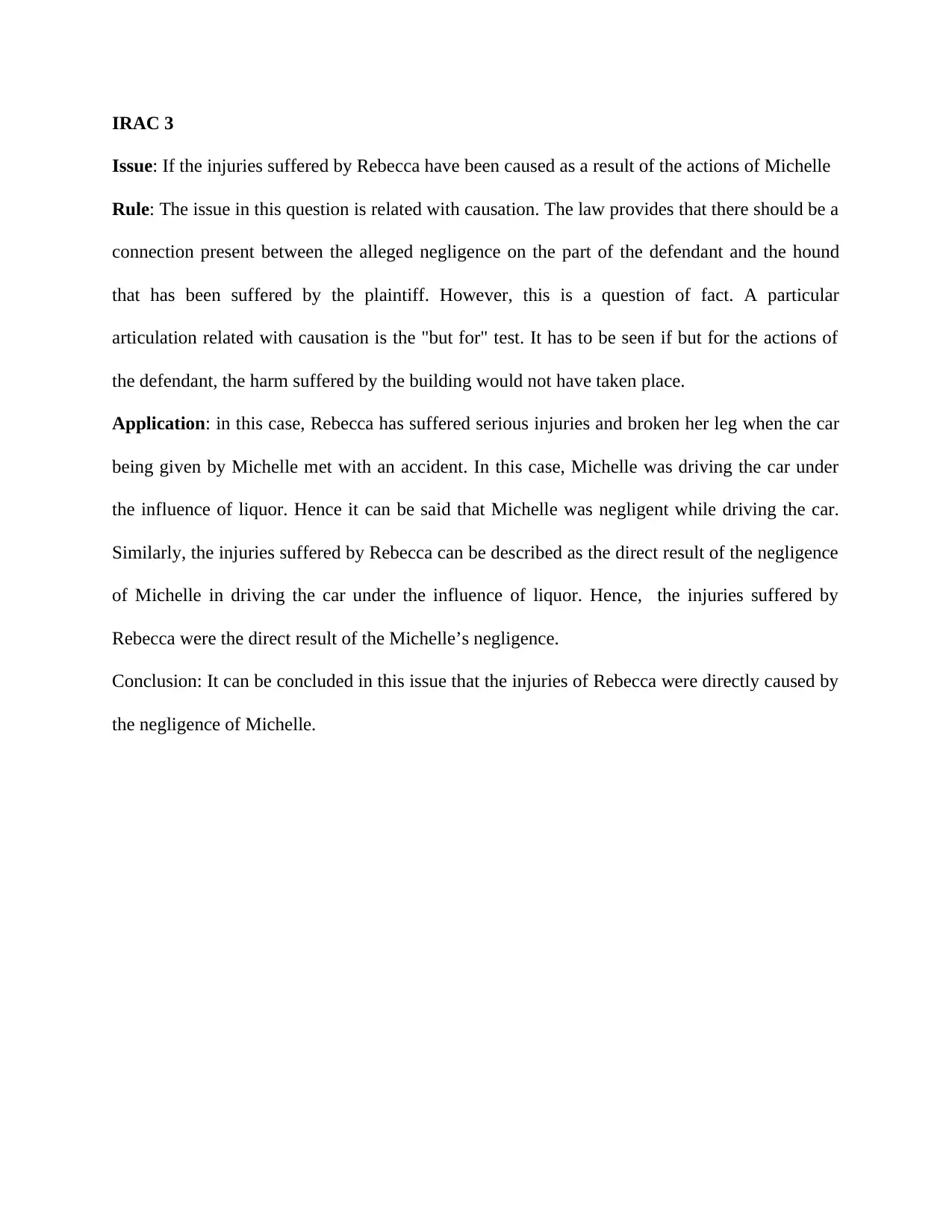
IRAC 3
Issue: If the injuries suffered by Rebecca have been caused as a result of the actions of Michelle
Rule: The issue in this question is related with causation. The law provides that there should be a
connection present between the alleged negligence on the part of the defendant and the hound
that has been suffered by the plaintiff. However, this is a question of fact. A particular
articulation related with causation is the "but for" test. It has to be seen if but for the actions of
the defendant, the harm suffered by the building would not have taken place.
Application: in this case, Rebecca has suffered serious injuries and broken her leg when the car
being given by Michelle met with an accident. In this case, Michelle was driving the car under
the influence of liquor. Hence it can be said that Michelle was negligent while driving the car.
Similarly, the injuries suffered by Rebecca can be described as the direct result of the negligence
of Michelle in driving the car under the influence of liquor. Hence, the injuries suffered by
Rebecca were the direct result of the Michelle’s negligence.
Conclusion: It can be concluded in this issue that the injuries of Rebecca were directly caused by
the negligence of Michelle.
Issue: If the injuries suffered by Rebecca have been caused as a result of the actions of Michelle
Rule: The issue in this question is related with causation. The law provides that there should be a
connection present between the alleged negligence on the part of the defendant and the hound
that has been suffered by the plaintiff. However, this is a question of fact. A particular
articulation related with causation is the "but for" test. It has to be seen if but for the actions of
the defendant, the harm suffered by the building would not have taken place.
Application: in this case, Rebecca has suffered serious injuries and broken her leg when the car
being given by Michelle met with an accident. In this case, Michelle was driving the car under
the influence of liquor. Hence it can be said that Michelle was negligent while driving the car.
Similarly, the injuries suffered by Rebecca can be described as the direct result of the negligence
of Michelle in driving the car under the influence of liquor. Hence, the injuries suffered by
Rebecca were the direct result of the Michelle’s negligence.
Conclusion: It can be concluded in this issue that the injuries of Rebecca were directly caused by
the negligence of Michelle.
⊘ This is a preview!⊘
Do you want full access?
Subscribe today to unlock all pages.

Trusted by 1+ million students worldwide
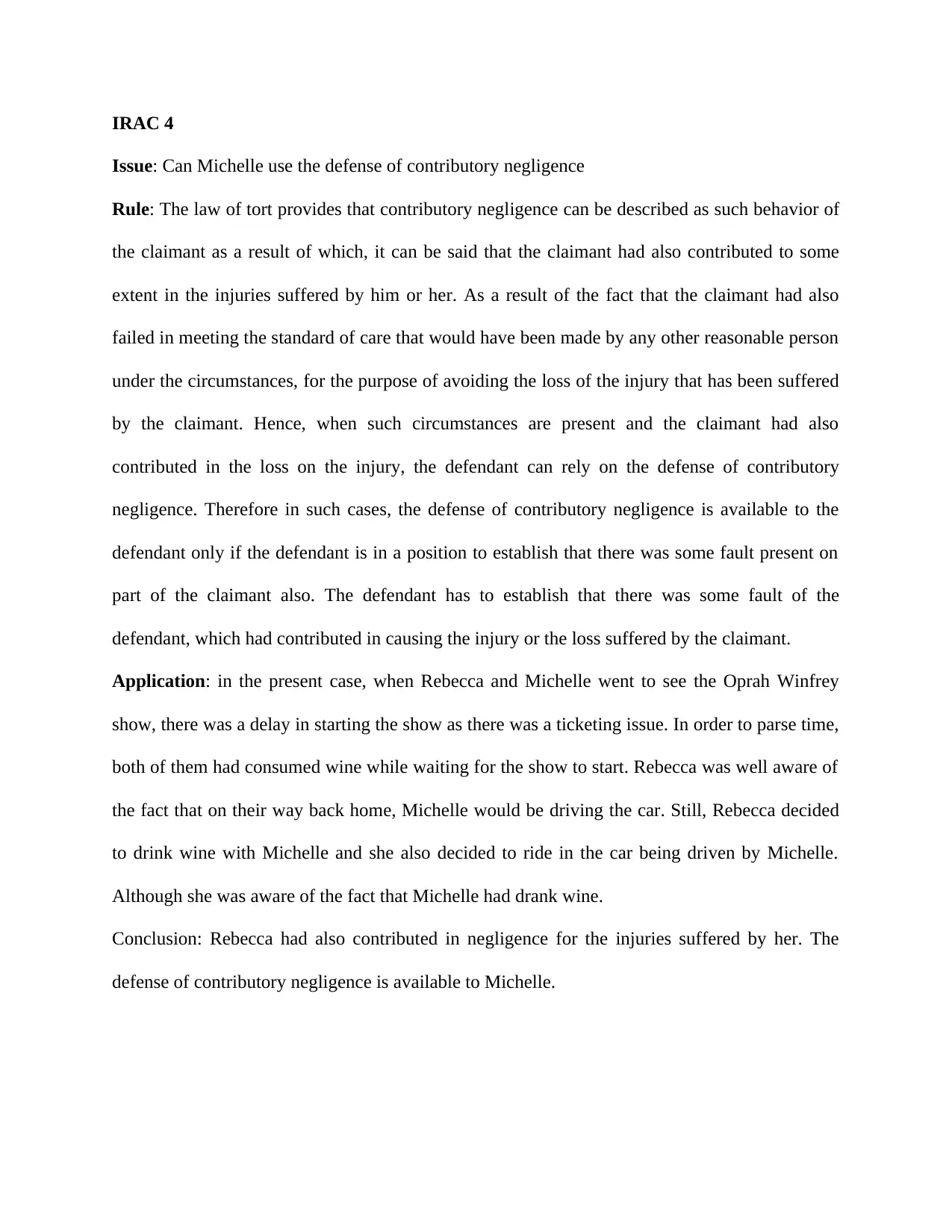
IRAC 4
Issue: Can Michelle use the defense of contributory negligence
Rule: The law of tort provides that contributory negligence can be described as such behavior of
the claimant as a result of which, it can be said that the claimant had also contributed to some
extent in the injuries suffered by him or her. As a result of the fact that the claimant had also
failed in meeting the standard of care that would have been made by any other reasonable person
under the circumstances, for the purpose of avoiding the loss of the injury that has been suffered
by the claimant. Hence, when such circumstances are present and the claimant had also
contributed in the loss on the injury, the defendant can rely on the defense of contributory
negligence. Therefore in such cases, the defense of contributory negligence is available to the
defendant only if the defendant is in a position to establish that there was some fault present on
part of the claimant also. The defendant has to establish that there was some fault of the
defendant, which had contributed in causing the injury or the loss suffered by the claimant.
Application: in the present case, when Rebecca and Michelle went to see the Oprah Winfrey
show, there was a delay in starting the show as there was a ticketing issue. In order to parse time,
both of them had consumed wine while waiting for the show to start. Rebecca was well aware of
the fact that on their way back home, Michelle would be driving the car. Still, Rebecca decided
to drink wine with Michelle and she also decided to ride in the car being driven by Michelle.
Although she was aware of the fact that Michelle had drank wine.
Conclusion: Rebecca had also contributed in negligence for the injuries suffered by her. The
defense of contributory negligence is available to Michelle.
Issue: Can Michelle use the defense of contributory negligence
Rule: The law of tort provides that contributory negligence can be described as such behavior of
the claimant as a result of which, it can be said that the claimant had also contributed to some
extent in the injuries suffered by him or her. As a result of the fact that the claimant had also
failed in meeting the standard of care that would have been made by any other reasonable person
under the circumstances, for the purpose of avoiding the loss of the injury that has been suffered
by the claimant. Hence, when such circumstances are present and the claimant had also
contributed in the loss on the injury, the defendant can rely on the defense of contributory
negligence. Therefore in such cases, the defense of contributory negligence is available to the
defendant only if the defendant is in a position to establish that there was some fault present on
part of the claimant also. The defendant has to establish that there was some fault of the
defendant, which had contributed in causing the injury or the loss suffered by the claimant.
Application: in the present case, when Rebecca and Michelle went to see the Oprah Winfrey
show, there was a delay in starting the show as there was a ticketing issue. In order to parse time,
both of them had consumed wine while waiting for the show to start. Rebecca was well aware of
the fact that on their way back home, Michelle would be driving the car. Still, Rebecca decided
to drink wine with Michelle and she also decided to ride in the car being driven by Michelle.
Although she was aware of the fact that Michelle had drank wine.
Conclusion: Rebecca had also contributed in negligence for the injuries suffered by her. The
defense of contributory negligence is available to Michelle.
Paraphrase This Document
Need a fresh take? Get an instant paraphrase of this document with our AI Paraphraser
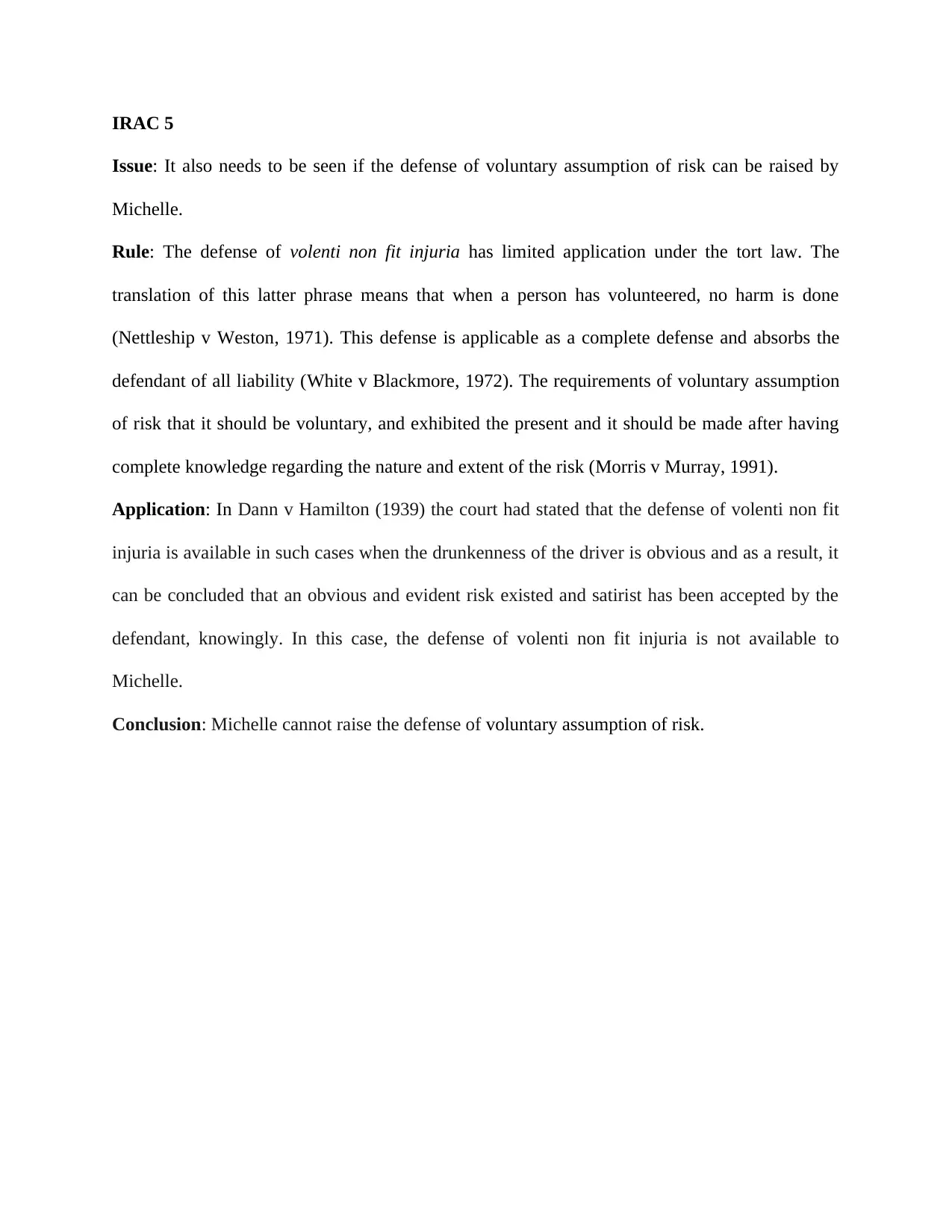
IRAC 5
Issue: It also needs to be seen if the defense of voluntary assumption of risk can be raised by
Michelle.
Rule: The defense of volenti non fit injuria has limited application under the tort law. The
translation of this latter phrase means that when a person has volunteered, no harm is done
(Nettleship v Weston, 1971). This defense is applicable as a complete defense and absorbs the
defendant of all liability (White v Blackmore, 1972). The requirements of voluntary assumption
of risk that it should be voluntary, and exhibited the present and it should be made after having
complete knowledge regarding the nature and extent of the risk (Morris v Murray, 1991).
Application: In Dann v Hamilton (1939) the court had stated that the defense of volenti non fit
injuria is available in such cases when the drunkenness of the driver is obvious and as a result, it
can be concluded that an obvious and evident risk existed and satirist has been accepted by the
defendant, knowingly. In this case, the defense of volenti non fit injuria is not available to
Michelle.
Conclusion: Michelle cannot raise the defense of voluntary assumption of risk.
Issue: It also needs to be seen if the defense of voluntary assumption of risk can be raised by
Michelle.
Rule: The defense of volenti non fit injuria has limited application under the tort law. The
translation of this latter phrase means that when a person has volunteered, no harm is done
(Nettleship v Weston, 1971). This defense is applicable as a complete defense and absorbs the
defendant of all liability (White v Blackmore, 1972). The requirements of voluntary assumption
of risk that it should be voluntary, and exhibited the present and it should be made after having
complete knowledge regarding the nature and extent of the risk (Morris v Murray, 1991).
Application: In Dann v Hamilton (1939) the court had stated that the defense of volenti non fit
injuria is available in such cases when the drunkenness of the driver is obvious and as a result, it
can be concluded that an obvious and evident risk existed and satirist has been accepted by the
defendant, knowingly. In this case, the defense of volenti non fit injuria is not available to
Michelle.
Conclusion: Michelle cannot raise the defense of voluntary assumption of risk.
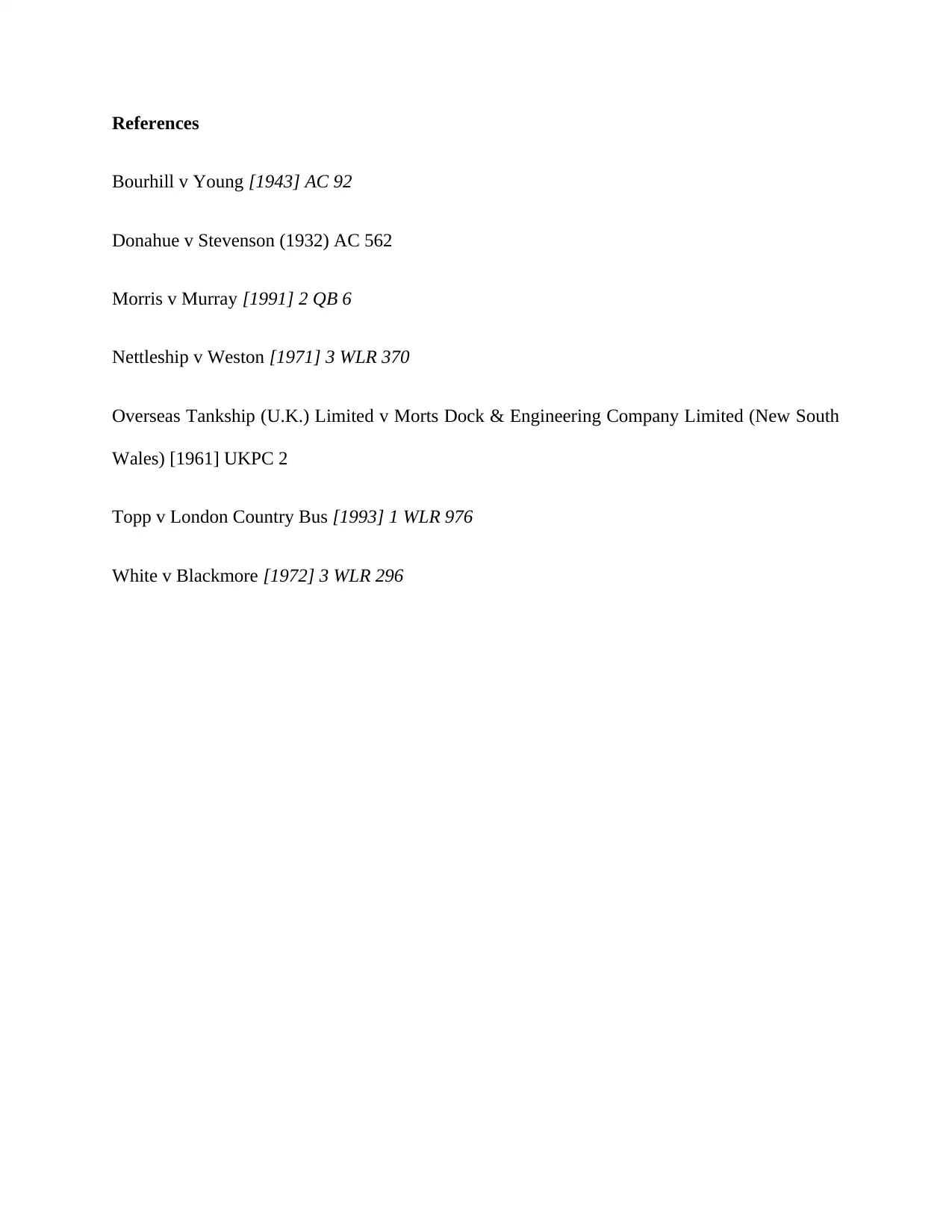
References
Bourhill v Young [1943] AC 92
Donahue v Stevenson (1932) AC 562
Morris v Murray [1991] 2 QB 6
Nettleship v Weston [1971] 3 WLR 370
Overseas Tankship (U.K.) Limited v Morts Dock & Engineering Company Limited (New South
Wales) [1961] UKPC 2
Topp v London Country Bus [1993] 1 WLR 976
White v Blackmore [1972] 3 WLR 296
Bourhill v Young [1943] AC 92
Donahue v Stevenson (1932) AC 562
Morris v Murray [1991] 2 QB 6
Nettleship v Weston [1971] 3 WLR 370
Overseas Tankship (U.K.) Limited v Morts Dock & Engineering Company Limited (New South
Wales) [1961] UKPC 2
Topp v London Country Bus [1993] 1 WLR 976
White v Blackmore [1972] 3 WLR 296
⊘ This is a preview!⊘
Do you want full access?
Subscribe today to unlock all pages.

Trusted by 1+ million students worldwide
1 out of 6
Related Documents
Your All-in-One AI-Powered Toolkit for Academic Success.
+13062052269
info@desklib.com
Available 24*7 on WhatsApp / Email
![[object Object]](/_next/static/media/star-bottom.7253800d.svg)
Unlock your academic potential
Copyright © 2020–2025 A2Z Services. All Rights Reserved. Developed and managed by ZUCOL.





